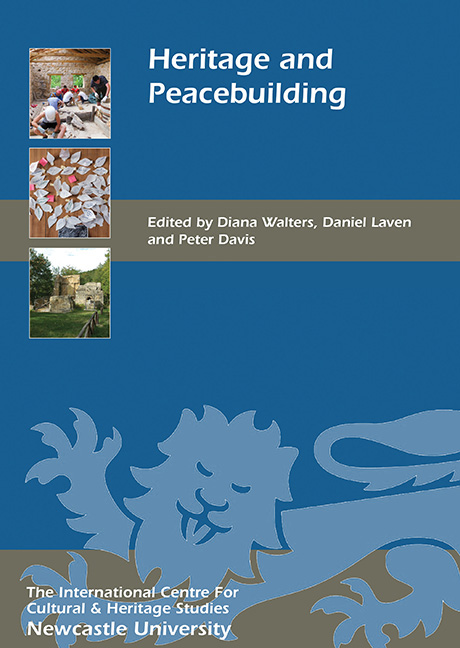Book contents
- Frontmatter
- Contents
- List of illustrations
- Acknowledgements
- List of abbreviations
- Preface
- Introduction
- NEW AND EMERGING IDEAS AROUND HERITAGE AND PEACE
- HERITAGE AND PEACEBUILDING IN PRACTICE
- HERITAGE, PEACEBUILDING AND SITES
- 14 A Conversation with Yongtanit Pimonsathean: Managing Conflict in Thailand
- 15 Challenging the Roots of Prejudice: the Monte Sole Case Study
- 16 Mau Mau: the Divisive Heritage of Liberation Struggle in Kenya
- 17 The Heritage of Geopolitical Borders as Peace Tourism Attractions
- 18 Rebuilding the Broken: Regional Restoration Camps as a Meeting Platform in the Western Balkans
- 19 Conflict or Reconciliation? Industrial Heritage Practices at a Turning Point
- 20 A Conversation with Saleem Ali: Environmental Challenges and Conflict Resolution
- List of Contributors
- Index
- Previous Titles
17 - The Heritage of Geopolitical Borders as Peace Tourism Attractions
from HERITAGE, PEACEBUILDING AND SITES
Published online by Cambridge University Press: 16 February 2018
- Frontmatter
- Contents
- List of illustrations
- Acknowledgements
- List of abbreviations
- Preface
- Introduction
- NEW AND EMERGING IDEAS AROUND HERITAGE AND PEACE
- HERITAGE AND PEACEBUILDING IN PRACTICE
- HERITAGE, PEACEBUILDING AND SITES
- 14 A Conversation with Yongtanit Pimonsathean: Managing Conflict in Thailand
- 15 Challenging the Roots of Prejudice: the Monte Sole Case Study
- 16 Mau Mau: the Divisive Heritage of Liberation Struggle in Kenya
- 17 The Heritage of Geopolitical Borders as Peace Tourism Attractions
- 18 Rebuilding the Broken: Regional Restoration Camps as a Meeting Platform in the Western Balkans
- 19 Conflict or Reconciliation? Industrial Heritage Practices at a Turning Point
- 20 A Conversation with Saleem Ali: Environmental Challenges and Conflict Resolution
- List of Contributors
- Index
- Previous Titles
Summary
In recent decades, globalisation has reshaped relationships between tourism development and geopolitical borders. For example, supranational processes have played an important role in decreasing tourism-related cross-border physical and administrative barriers between countries. Supranational associations, such as the European Union (EU) or The North American Free Trade Agreement (NAFTA), deal with many issues that affect tourism directly, even though tourism is not defined as their main concern (Timothy 2001). Examples of the positive transformation trend toward more open borders can be seen in the opening of Tibet and some other parts of China to tourists since the 1990s and the opening of the borders between the Turkish and Greek sides of Cyprus since 2003, and there are even some signs of a less isolationist stance towards international tourists in North Korea (Timothy 2006).
The varying effects of cross-border openness on tourism development can be described as a process of change along a time axis (Timothy 2001; Gelbman and Timothy 2010). A closed and fortified border means an absence of tourism development and little if any tourism access to the border area for security and political reasons. At times, one-sided border attractions develop, allowing tourists of one country to overlook the ‘other side’. With geopolitical changes, the border may undergo a transformation and become an open boundary. The boundary line can then become a tourist attraction that focuses mainly on the history and heritage of the place but also offers the possibility of developing more varied tourism products in the formerly closed border areas in which it develops (Gelbman and Timothy 2010).
Tourism has been mentioned as a social force that can contribute to and promote international understanding, cooperation and global good will for establishing and maintaining world peace (D'Amore 1988; Litvin 1998; Kim et al 2007). Heritage development suggests that tourism efforts can help ease tensions and promote cross-cultural dialogue and reconciliation, particularly when such development is community-based or ‘bottom-up’ (Giblin 2014). For example, border tourism attractions often present the story of local heritage and historical events as well as of the natural environment, which can generate interest among visitors (Zeppel and Hall 1992; Timothy 2001).
- Type
- Chapter
- Information
- Heritage and Peacebuilding , pp. 191 - 204Publisher: Boydell & BrewerPrint publication year: 2017



